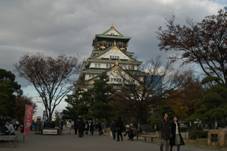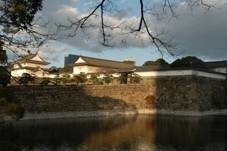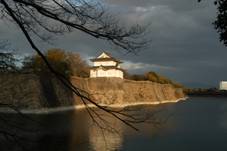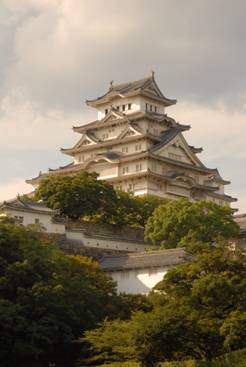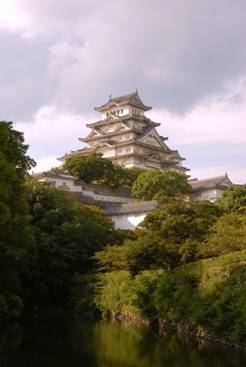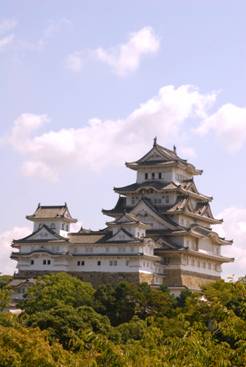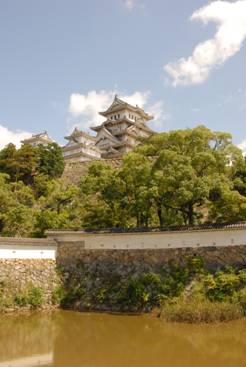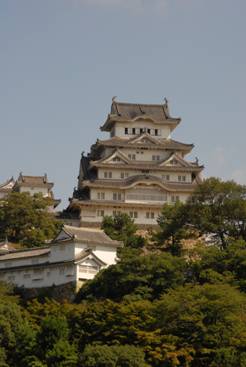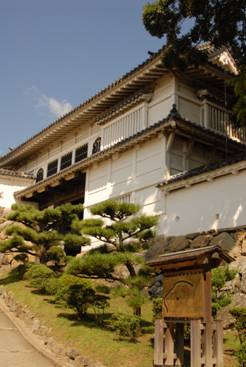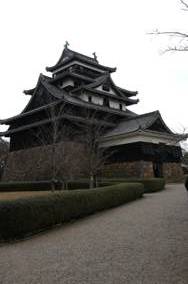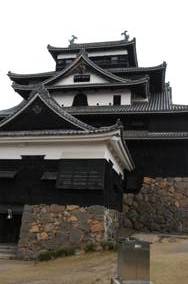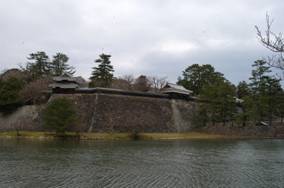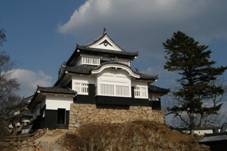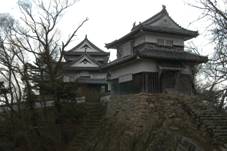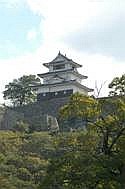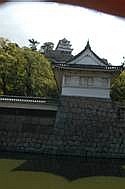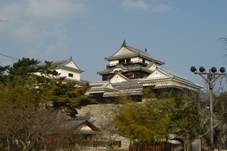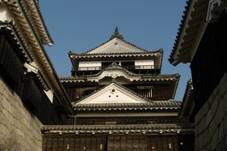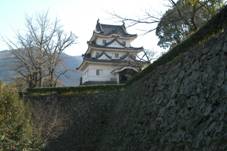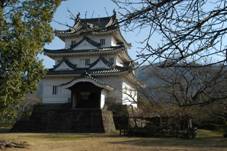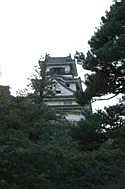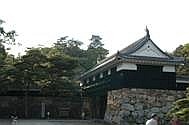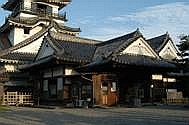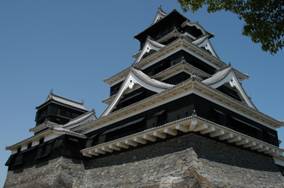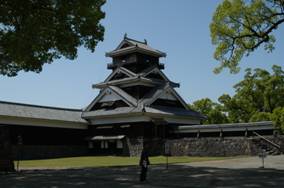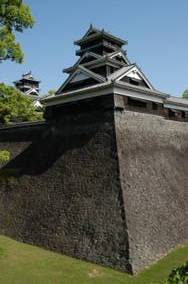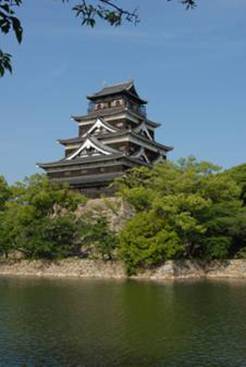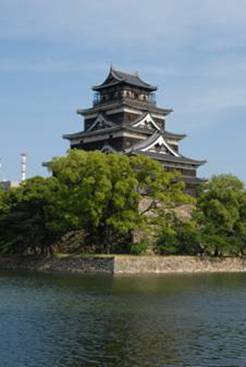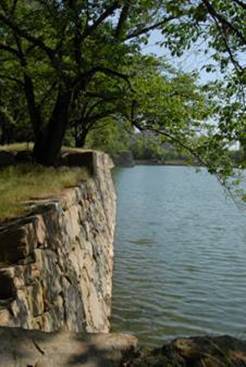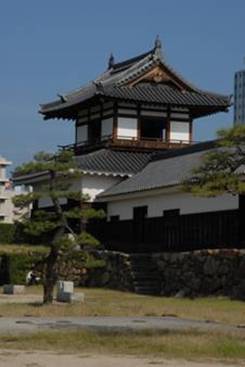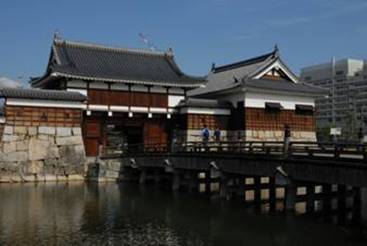|
TAK'S
GUIDE TO JAPANESE CASTLES |
|
OSAKA-JO |
|
|
Donjon reconstructed after World War II |
|
|
AKA |
KIN-JO |
|
LOCATION |
OSAKA-City, |
|
CONSTRUCTOR |
Toyotomi Hideyoshi |
|
YEAR OF CONSTRUCTION |
1583 |
|
REMAINS |
Central keep, secondary keep, stone works, moats, towers, gates |
|
MY FIRST VISIT |
1996 |
|
NOTES |
Osaka-jo was first built by Toyotomi Hideyoshi, ruler of The Edo Shogunate,
who wanted to rid the world of anything that remotely reminded the existence
of the Toyotomi
family, decided to rebuild Osaka-jo from the ground up. As a result, remains of the Toyotomi Osaka-jo
(stone works) were buried deep in the ground, and the Shogunate
Osaka-jo
was built on top of it. The donjon of the Shogunate
Osaka-jo
was second in size to that of Edo-jo,
the seat of the Shogunate. Like the donjon of Edo-jo, Osaka-jo's donjon
was lost in fire shortly after its completion. Although the castle saw no battle for
two hundred years, it became the center of battle near the end of the Shogunate era. Today, centerpiece of the castle is
not the corner towers remaining, but stone works constructed from gigantic
stones. |
|
Gate and tower
Corner tower and stone works |
|
|
HIMEJI-JO |
|
|
|
|
|
AKA |
HAKURO-JO |
|
LOCATION |
HIMEJI City, HYOGO |
|
CONSTRUCTOR |
Ikeda Terumasa |
|
YEAR OF CONSTRUCTION |
1601 |
|
REMAINS |
Bizen keep (centrail
keep), Nishi keep (west keep), tertiary keep, moats, donjon ('National
Treasure'), towers |
|
MY FIRST VISIT |
1994 |
|
NOTES |
The current Himeji-jo was built by Ikeda Terumasa
in 1601, by order of Tokugawa Ieyasu, who later became the first Shogun of the Edo Shogunate. Himeji-jo was built at the time
of final struggle for the establishment of the Edo Shogunate.
Therefore, it was built to repel any enemy assault. But it saw no battle in
its four hundred year history. Although the entire castle complex was
preserved when it became a government property after the Meiji Restoration
(end of Shogun's rule) in 1867, the Meiji Government tore down many
structures until they eventually realized its cultural significance. Even though the structures remaining
today are only fraction of what was remaining at the time of the Meiji
Restoration, Himeji-jo
is the best preserved example of Japanese military architecture in the Shogun
era, and the most famous castle in Japan. The donjon of Himeji-jo is designated
'National Treasure', and the entire castle complex is designated 'World Cultural
Heritage' by UNESCO. |
|
|
|
|
MATSUE-JO |
|
|
Donjon |
|
|
AKA |
Chidori-jo |
|
LOCATION |
MATSUE City, SHIMANE |
|
CONSTRUCTOR |
Horie Yoshiharu |
|
YEAR OF CONSTRUCTION |
1995 |
|
REMAINS |
Central keep, secondary keep, stone works, moat, donjon |
|
MY FIRST VISIT |
1996 |
|
NOTES |
Matsue-jo was built by Horie Yoshiharu in 1611. It took five years to complete. Retainer of the
castle changed hands frequently until it was handed down to the Yuki family. All structures were torn down after
the Meiji Restoration (end of Shogun's rule) in 1867, with the exception of
the donjon. The overall height of the donjon is 30
meters, which is third among existing donjons, next to that of Himeji-jo and Matsumoto-jo. In terms of floor area, Matsue-jo's donjon is second largest,
after that of Himeji-jo's. |
|
Donjon
Corner towers
and walls newly reconstructed |
|
|
BICCHU-MATSUYAMA-JO |
|
|
Donjon |
|
|
AKA |
TAKAHARI-JO |
|
LOCATION |
BICCHU-TAKAHARI City, OKAYAMA |
|
CONSTRUCTOR |
Mizutani Katsumune |
|
YEAR OF CONSTRUCTION |
1583 |
|
REMAINS |
Central keep, secondary keep, tertiary keep, stone works, donjon,
towers, castle walls |
|
MY FIRST VISIT |
1996 |
|
NOTES |
Bicchu-Matsuyama-jo was for a
long time under the control of the Mori
family, a powerful regional warlord. After the Sekigahara
War in 1600, the Mori family was
forced to give up the castle and surrounding territories. From then on,
retainer changed hands frequently until the Meiji Restoration (end of Shugun's rule) in 1867. The official name of the castle is
simply 'Matsuyama-jo',
but there are many castles in Japan similarly named 'Matsuyama'. For academic
purposes, former province name (in this case 'Bicchu') is added as a prefix
for differentiation. |
|
Tower and
donjon |
|
|
MARUGAME-JO |
|
|
Donjon |
|
|
AKA |
KAMEYAMA-JO |
|
LOCATION |
MARUGAME-City, KAGAWA |
|
CONSTRUCTOR |
|
|
YEAR OF CONSTRUCTION |
1597 |
|
REMAINS |
Central keep, secondary keep, tertiary keep, donjon, gate |
|
MY FIRST VISIT |
1995 |
|
NOTES |
Construction of Magugame-jo began in 1597, and
was completed in 1602. But in 1615, it was demolished because of the 'Ikkoku Ichijo Rei (one castle per province law)'. Magugame-jo was rebuilt by Yamazaki Ieharu
in 1641. Major feature of this castle is that
the entire Kameyama hill, nearly 60 meters high, is
covered with stone works. |
|
Donjon and
gate |
|
|
IYO-MATSUYAMA-JO |
|
|
Donjon and towers |
|
|
AKA |
KATSUYAMA-JO, KINKI-JO |
|
LOCATION |
MATSUYAMA City, EHIME |
|
CONSTRUCTOR |
Kato Yoshiaki |
|
YEAR OF CONSTRUCTION |
1602 |
|
REMAINS |
Central keep, secondary keep, stone works, donjon, corner towers,
gates |
|
MY FIRST VISIT |
1994 |
|
NOTES |
Iyo-Matsuyama-jo (Matsuyama is
a common name for a castle, so for academic purposes, differentiation is made
by adding former province name as prefix), was constructed in 1602 by Kato Yoshiaki. Yoshiaki desperately wanted to build a castle in Katsuyama hill. Knowing that the Shogunate
will never permit construction in Katsuyama if
requested first, Yoshiaki listed Katsuyama hill as
an alternate location for a new castle. The Shogunate,
as Yoshiaki expected, rejected the first site proposed and permitted
construction in the alternate location. Donjon, when it was first completed,
was five stories tall, but it was later renovated to three stories. The
official reason was that the ground was too weak to support a five storey
structure, but in truth, it was scaled down to escape the constant watch of
the Shogunate, suspicious of any warlords with
grand castles (i.e. with enough financial and military powers to overthrow
the Shogunate). Matsuyama-jo faired well
against the Meiji Restoration (end of the Shogunate)
and the Second World War, but many structures were destroyed in 1949 by an
arsonist. |
|
Donjon |
|
|
UWAJIMA-JO |
|
|
Donjon |
|
|
AKA |
TSURUJIMA-JO, MARUGUSHI-JO, ITAJIMA-JO |
|
LOCATION |
UWAJIMA City, EHIME |
|
CONSTRUCTOR |
Todo Takatora |
|
YEAR OF CONSTRUCTION |
1596 |
|
REMAINS |
Central keep, secondary keep, stone works, donjon |
|
MY FIRST VISIT |
1995 |
|
NOTES |
Uwajima-jo was constructed by Todo Takatora,
and was later renovated by Date Munetoshi who became the lord of the province.
Current donjon was built during this time. Only structure remaining is the donjon. Ehime prefecture is noted for castles
with donjons remaining. There are two (the other is
Iyo-Matsuyama-jo). This is rare, because most prefectures have not a single castle with
donjon remaining (there were many castles with no donjons built in the first
place; this was done to escape the watch of the Shogunate,
suspicious of any warlords with grand castles). |
|
Donjon |
|
|
KOCHI-JO |
|
|
Donjon |
|
|
AKA |
TAKA-JO, OTAKASAKA-JO |
|
LOCATION |
KOCHI City, KOCHI |
|
CONSTRUCTOR |
Yamauchi Kazutoyo |
|
YEAR OF CONSTRUCTION |
1603 |
|
REMAINS |
Central keep, secondary keep, tertiary keep, stone works, donjon,
palace, gates, towers |
|
MY FIRST VISIT |
1995 |
|
NOTES |
Kochi-jo was built in 1603 by Yamauchi Kazutoyo, on Otakasakayama hill. Majority of the castle was destroyed
by fire in 1727. The castle was rebuilt completely in 1753. Structures
currently remaining in the central keep are from this reconstruction. In 1873, all structures within the
castle was demolished, with the exception of the Otemon
(main gate) and the structures of the central keep. Kochi-jo is presently noted for the fact that is it the
only castle in |
|
Otemon (main gate), and the donjon in the background
Donjon and
the Kaitokukan (central keep palace) |
|
|
KUMAMOTO-JO |
|
|
Donjon, reconstructed after World War
II |
|
|
AKA |
GINNAN-JO |
|
LOCATION |
KUMAMOTO City, KUMAMOTO |
|
CONSTRUCTOR |
Kato Kiyomasa |
|
YEAR OF CONSTRUCTION |
1601 |
|
REMAINS |
Central keep, stone works, moats, corner towers, castle walls |
|
MY FIRST VISIT |
1996 |
|
NOTES |
Kumamoto-jo was constructed by Kato Kiyomasa in 1601. Kiyomasa, a powerful warlord,
built Kumamoto-jo
not only as the seat of his government, but as a fortress for a major battle.
As a result, Kato family came under
a constant and suspicious watch of the Shogunate.
The Kato family was eventually
discontinued. Kumamoto-jo was retained by the Hosokawa family until the Meji
Restoration (end of the Shogunate). Majority of the castle structures
remaining was destroyed in the Seinan War, started
by Saigo Takamori. Takamori, although a key player
in bringing the end to the Shogunate, was dissatisfied
by the new Meiji government which he helped to create. He started a war along
with other former samurais, but was defeated by better equipped Meiji forces. |
|
Udo-yagura (Udo Tower), one of the
few structures in the castle still remaining. It is said that it was the former
donjon of Udo-jo (proved untrue
by recent investigation).
|
|
l
|
HIROSHIMA-JO |
|
|
Donjon, reconstructed after World War
II |
|
|
AKA |
RI-JO, ZAIMA-JO |
|
LOCATION |
|
|
CONSTRUCTOR |
Mohri Terumoto |
|
YEAR OF CONSTRUCTION |
1592 |
|
REMAINS |
Central keep, stone works, moats |
|
MY FIRST VISIT |
1993 |
|
NOTES |
Hiroshima-jo was constructed by Mohri Terumoto, a major warlord of the
region. But after the Sekigahara War (the War against Tokugawa
Ieyasu (East) and Toyotomi family (West)), Hiroshima-jo's was awarded
to Fukushima Masanori, who had long
sided with Toyotomi
family, but allied with Tokugawa Ieyasu just before Sekigahara. This shift
encouraged other warlords to change sides, which lead to Ieyasu's victory. However, Masanori's rule did not last long. He was accused of repairing
the castle without the Shogunate's permission (the Shogunate strictly prohibited construction of new
castles, and demanded permission for any repairs or refurbishment), and was
soon dismissed. The castle was then awarded to the Azano family,
who ruled Donjon remained standing up until
World War II. When it was just about to survive the war, it was blasted to
pieces by the detonation of the first nuclear weapon in history, the Little Boy. |
|
Donjon, stone wall and moat,
reconstructed Corner Tower
Reconstructed Gate House and |
|
